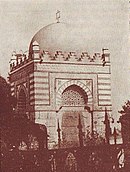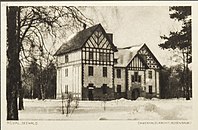Jacques Rosenbaum
Jacques Rosenbaum (born July 1, 1878 in Haapsalu ; † January 6, 1944 in Berlin ) was a German-Baltic architect, and from 1921 Estonian. He is best known for his Art Nouveau buildings in Tallinn.
Life
Rosenbaum was born as Jacques Gustav-Adolf Rosenbaum-Ehrenbush into a wealthy family of Baltic Germans . His father was a lawyer, whose father was also an architect. Jacques Rosenbaum grew up in Haapsalu and Tallinn and began studying chemistry and architecture at the Riga Polytechnic in 1896 . He became active in the Corps Rubonia and graduated in 1904. He then became a city architect in Dorpat before moving to Reval in 1907. The first projects in Reval were still in the neo -renaissance style . Rosenbaum was married to Adrienne Kerkovius since 1897. The couple had five children.
Art Nouveau architecture in Reval
Rosenbaum's work in Reval produced a number of buildings in the period from 1907 to 1919 that were built in the Art Nouveau or Art Nouveau-like forms.
In 1908 Rosenbaum built his first building on Pikk-Gasse in Tallinn's old town at number 23/25, where Rosenbaum's penchant for decorating the facades can be seen. Due to the various elements, the building cannot be clearly assigned to a style, but combines elements of Art Nouveau, Neo-Renaissance and Neo- Mannerism . A sculpture on the facade depicts an old man staring through his lorgnette at the street that served as the basis for some of the townspeople's stories and speculations about this figure. These and other figures were created by the Riga sculptor August Volz . Similarities with the theoretical designs by Camillo Sitte indicate that Rosenbaum was inspired by Sitte's concepts for his extravagant facades.
In 1909 Rosenbaum completed another project for a bank on Harju Street at number 9. The original design provided for a much more unusual facade in the Art Nouveau style, which, however, was revised before completion and opened with a much more traditional facade with elements of historicism. During the Second World War , the building was badly damaged and many elements of the facade were lost during the later renovation, which is why it can now be assigned to the Neo-Renaissance style.
The Pikk 18 building was completed by Rosenbaum in 1910, directly opposite Pikk 23/25, and is one of the most famous Art Nouveau buildings in Tallinn. Two dragons, again created by August Volz, adorn the façade and frame a single, curved window on the ground floor - above that are two statues of stern-looking Egyptian women. The facade is thematically closed by two herms . As is customary in Art Nouveau, these facade elements should convey a certain message about the function or meaning of the building, but there is no consensus in this building about what the intended symbolism should be.
Another project was the apartment building at Roosikrantsi 15, which Rosenbaum built for Gustav Leppenberg from 1911 to 1912 . The symmetrical facade combines elements of Art Nouveau and Baroque . In this building, Rosenbaum's biographer Karin Hallas-Murula sees influences from the much livelier Art Nouveau scene in Riga, as well as influences from the architects Michail Ossipowitsch Eisenstein and Otto Wagner . In addition to residential buildings, he also designed factory buildings (Fahle cellulose factory; Grünewaldt leather factory); Hospitals (building in Seewald psychiatric clinic) and a Jewish mausoleum.
Later career
Rosenbaum moved to Greifswald in 1919 , but returned to Tallinn a year later, where he took Estonian citizenship in 1921 and became a partner in an architecture firm. However, his architectural style was out of fashion and for the young Estonian nation other ideals were being sought in architecture, which is why the later buildings were more modest.
In 1928 Rosenbaum moved back to Germany, where he and his wife became a member of the NSDAP in 1932 . In the 1930s he worked as a technician for the Air Force , in 1942 he moved to the Reich Ministry for Armaments and Ammunition , and in 1943 he became a consultant for the Todt Organization in occupied Riga . Because of his poor health, he returned to Berlin in the same year, where he died on January 6, 1944.
Works
| building | address | Manufacturing time | photo |
|---|---|---|---|
| Reichmann's building | Pikk 23/25, Tallinn | 1908-1909 | |
| Levinovich's Mausoleum (destroyed) | Siselinna Cemetery, Tallinn | 1910 | |
| Laupa mansion | Järvamaa, Estonia | 1910-1913 | |
| Leppenberg's apartment house | Roosikrantsi 15, Tallinn | 1912 | |
| Mariners house | Uus-Sadama 14 / Tuukri 13, Tallinn | 1924-1926 | |
| Ferdinand Treublut's house (Drakonigalerie) | Pikk 18, Tallinn | 1909-1910 | |
| Höppener & Co Bank | Harju 9, Tallinn | 1908-1909 | |
| Own houses | Pirita Str. 10 (destroyed) and 12, Tallinn | ||
Seewald Psychiatric Clinic
|
Paldiski Str. 52, Tallinn | 1908-1910 | |
Buildings in Pale Cellulose Factory
|
Masina 20; 22, Tallinn | 1911-1914 |
Web links
Individual evidence
- ↑ a b c d e f Karin Hallas-Murula: Tallinna Juugendarhitektuur: Jacques Rosenbaum (1878–1944) . Eesti Arhitektuurimuuseum, 2010, ISBN 978-9985-9828-7-7 (Estonian).
| personal data | |
|---|---|
| SURNAME | Rosenbaum, Jacques |
| ALTERNATIVE NAMES | Rosenbaum-Ehrenbush, Jacques Gustav-Adolf |
| BRIEF DESCRIPTION | Estonian architect |
| DATE OF BIRTH | July 1, 1878 |
| PLACE OF BIRTH | Haapsalu |
| DATE OF DEATH | January 6, 1944 |
| Place of death | Berlin |











